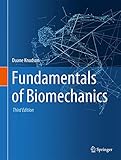Fundamentals of Biomechanics [electronic resource] / by Duane Knudson.
By: Knudson, Duane [author.] .
.
Contributor(s): SpringerLink (Online service) .
.
Material type:  BookPublisher: Cham : Springer International Publishing : Imprint: Springer, 2021Edition: 3rd ed. 2021.Description: XI, 252 p. 149 illus., 141 illus. in color. online resource.Content type: text Media type: computer Carrier type: online resourceISBN: 9783030518387.Subject(s): Human physiology
BookPublisher: Cham : Springer International Publishing : Imprint: Springer, 2021Edition: 3rd ed. 2021.Description: XI, 252 p. 149 illus., 141 illus. in color. online resource.Content type: text Media type: computer Carrier type: online resourceISBN: 9783030518387.Subject(s): Human physiologyPart I: Introduction -- Introduction to Biomechanics of Human Movement -- Fundamentals of Biomechanics and Qualitative Analysis -- Part II: Biological/Structural Bases -- Anatomical Description and Its Limitations -- Mechanics of the Musculoskeletal System -- Part III: Mechanical Bases -- Linear and Angular Kinematics -- Linear Kinetics -- Angular Kinetics -- Fluid Mechanics -- Part IV: Applications of Biomechanics in Qualitative Analysis -- Applying Biomechanics in Physical Education -- Applying Biomechanics in Coaching -- Applying Biomechanics in Strength and Conditioning -- Applying Biomechanics in Sports Medicine and Rehabilitation -- Appendices -- Index.
This third edition introduces the exciting world of how human movement is created and how it can be enhanced. The book presents a comprehensive review of the major concepts of biomechanics and summarizes them in nine principles of biomechanics. Throughout the text are numerous examples of applying these principles to the work of kinesiology professionals with references to current biomechanics research. Specific case studies illustrate how biomechanics principles can be used in evidence-based practice by professionals to modify movement in teaching/coaching and exercise/rehabilitation settings. This text presents a clear, conceptual understanding of biomechanics and is designed to help students through active learning lab activities to link their personal experience to biomechanical concepts. Biomechanics instructors, researchers, and other professionals helping people to improve movement and decrease the risk of injury, as well as advanced students learning biomechanical principles in biomedical engineering, ergonomics, kinesiology, physics, and sports physiology will find Fundamentals in Biomechanics, 3rd edition invaluable. Key Features: Detailed examples of biomechanical principles and their application in the qualitative diagnosis of human movement in a variety of professions Over 160 figures illustrating real human movement Case studies of actual movement technique examined by professionals in human movement Extensive use of graphs, photographs, illustrations, and citations to important biomechanics literature Glossary of key terms and biomechanics research terminology Appendix of instructional lab activities Endorsements of the 2nd Edition: : "Fundamentals in Biomechanics delivers everything it promises, and more. The challenge of teaching and learning biomechanics is understanding the two distinct fields that it comprises - biology and mechanics. In my experience, some students enter biomechanics with aptitude and interest in one of these fields and reluctance to the others. As a leader in biomechanics, Dr. Knudson seems to realize this and does an expert job of teaching these two fields in separate parts of the textbook. The text is clearly written, and includes many helpful illustrations and examples." Glenn S. Fleisig, Ph.D., Smith and Nephew Chair of Research, American Sports Medicine Institute, Birmingham, AL "Fundamentals of Biomechanics is a wonderful and comprehensive treatment which meets the needs and interest of both students and educators! The text addresses the subject cohesively and solidly in a technical, yet very readable and effective manner...I'll use this text in my own summer course and recommend it to colleagues." Jani Macari Pallis, Ph.D., International Sports Engineering Association, San Francisco, CA.


There are no comments for this item.